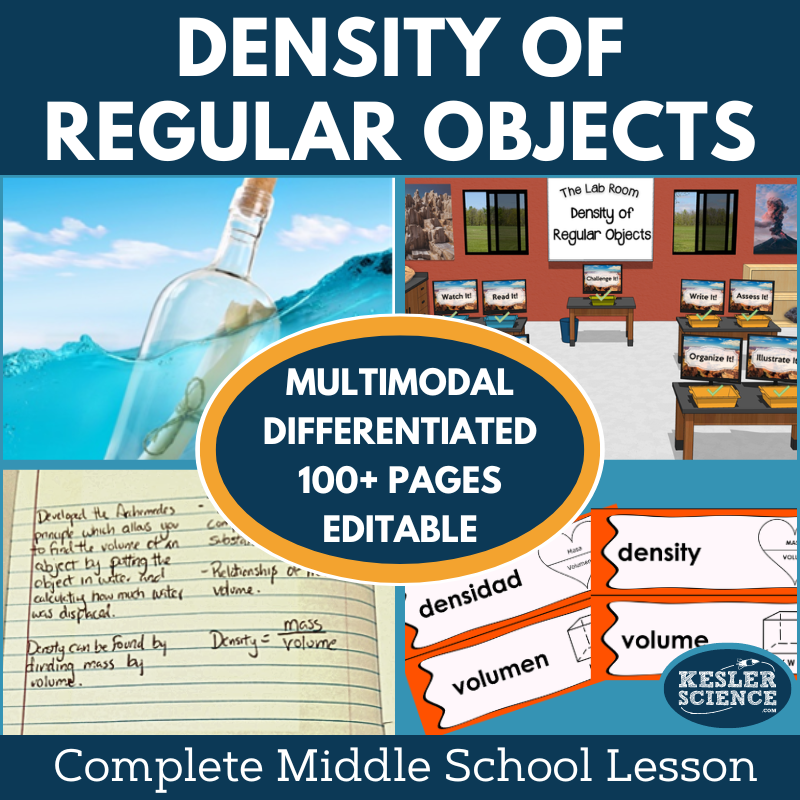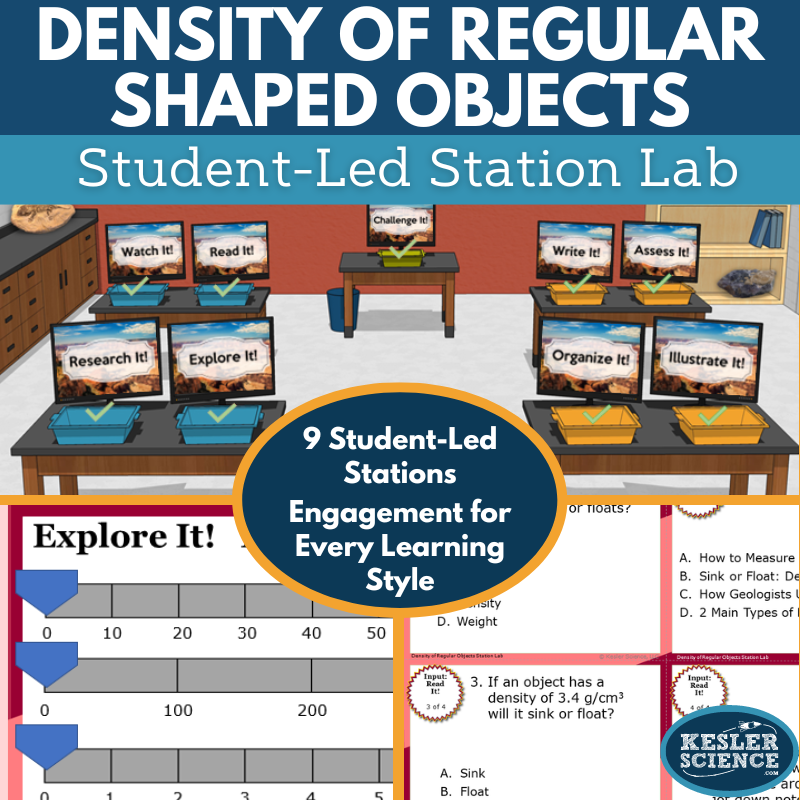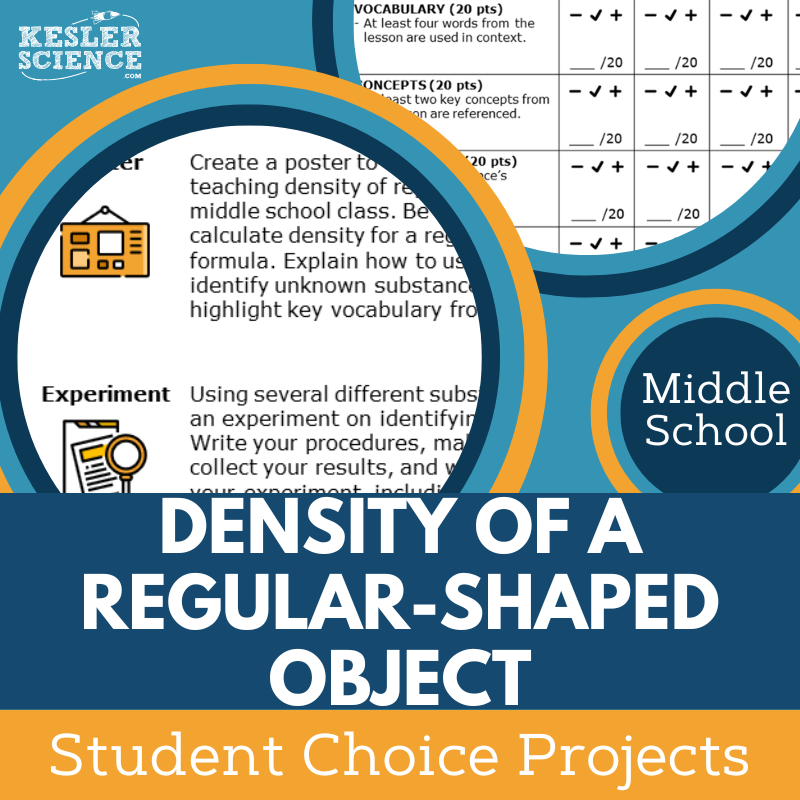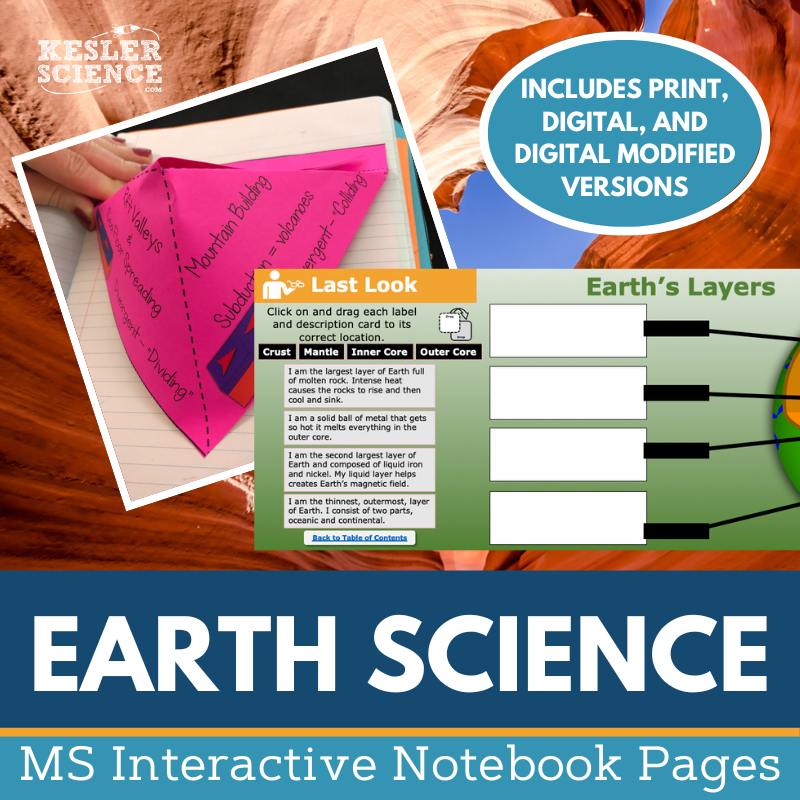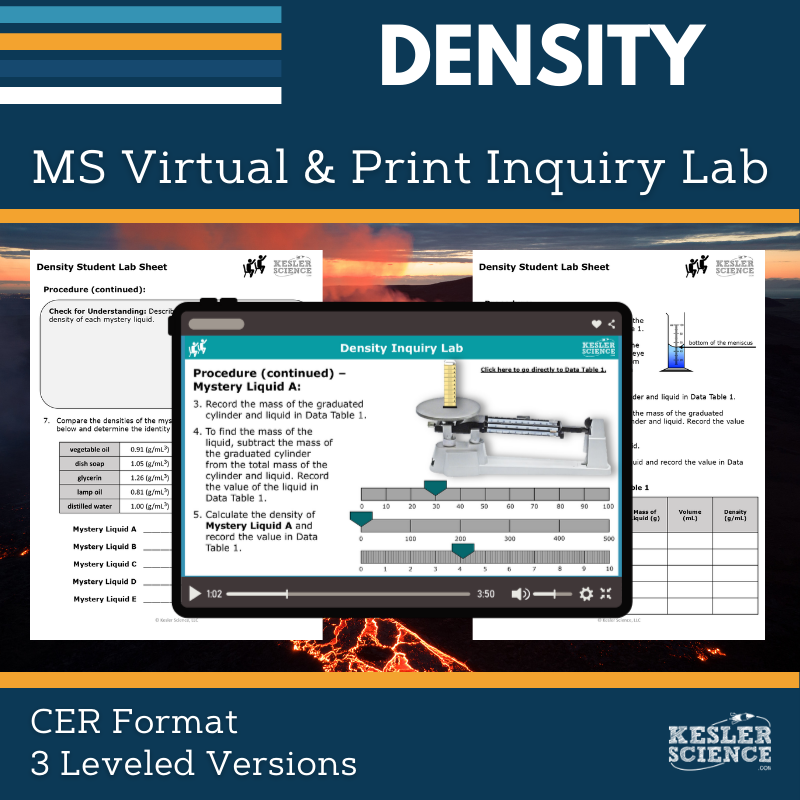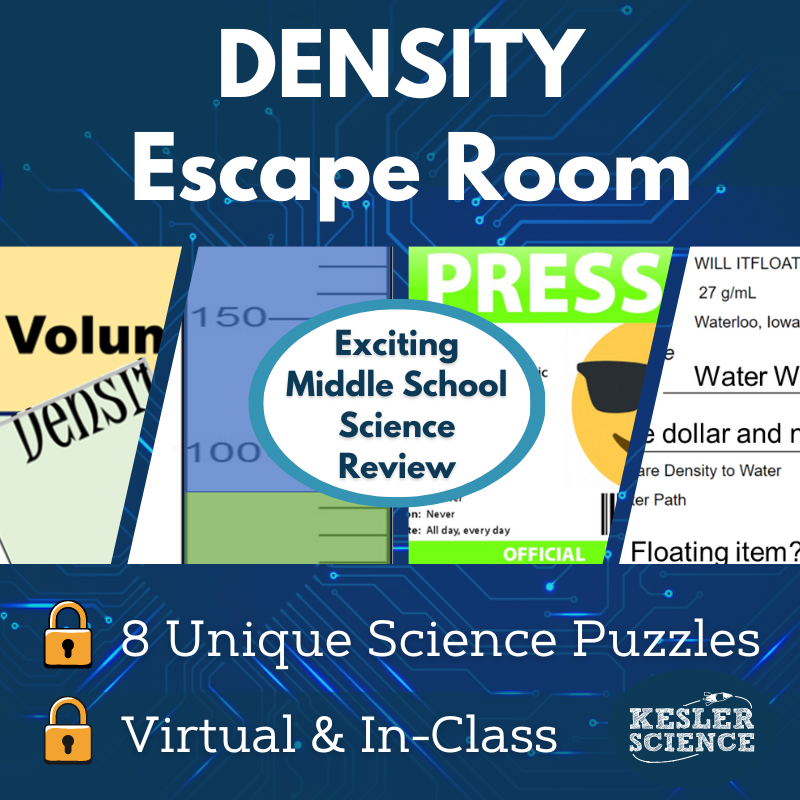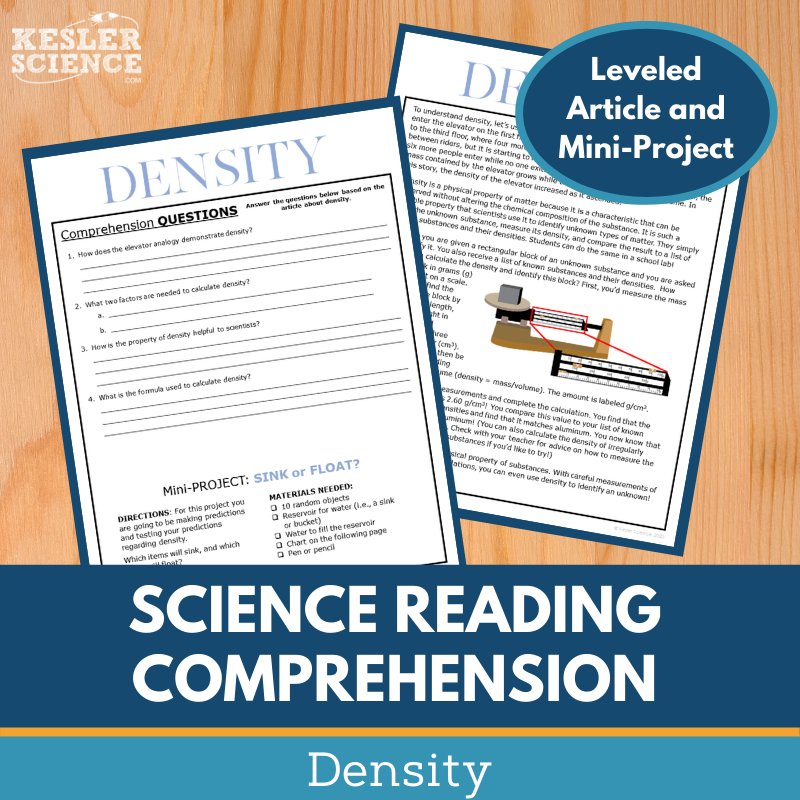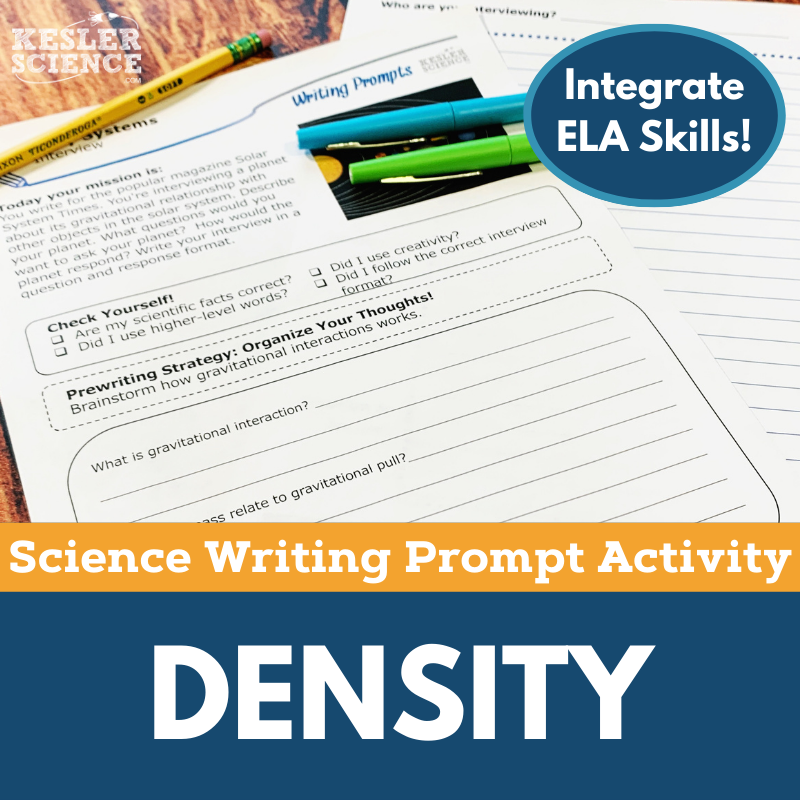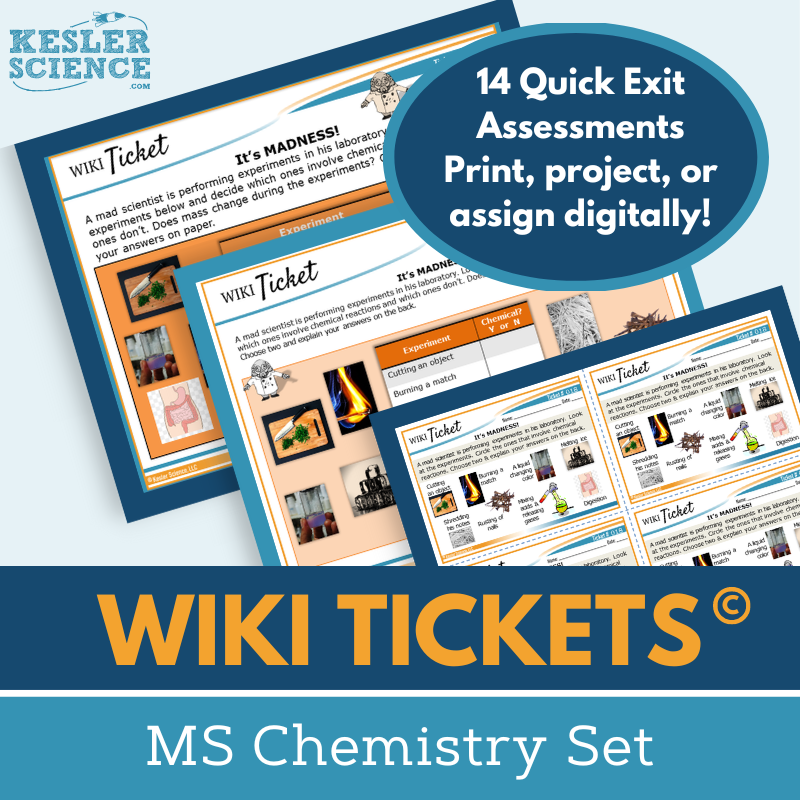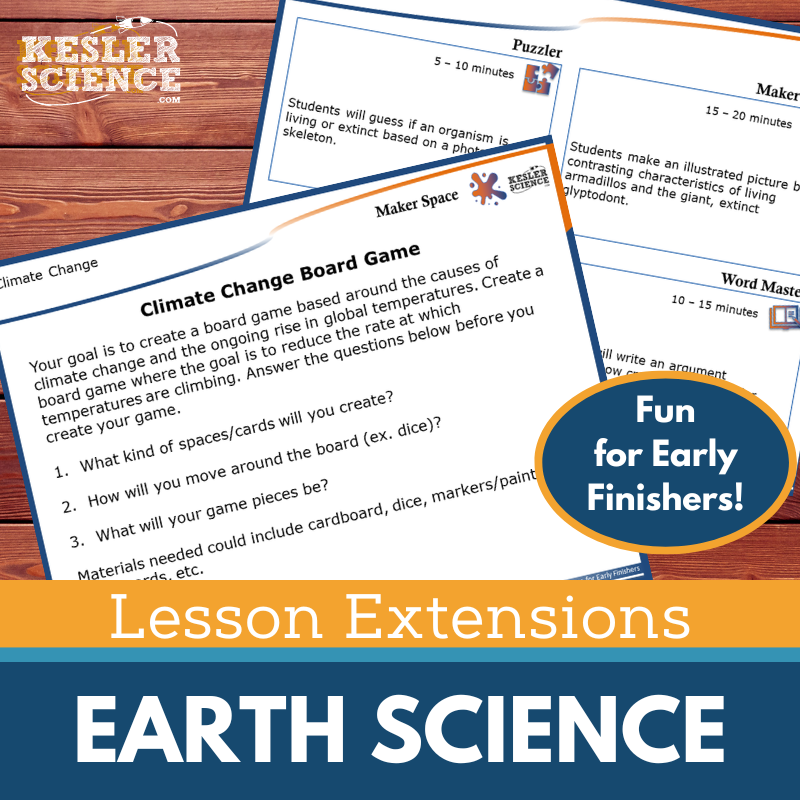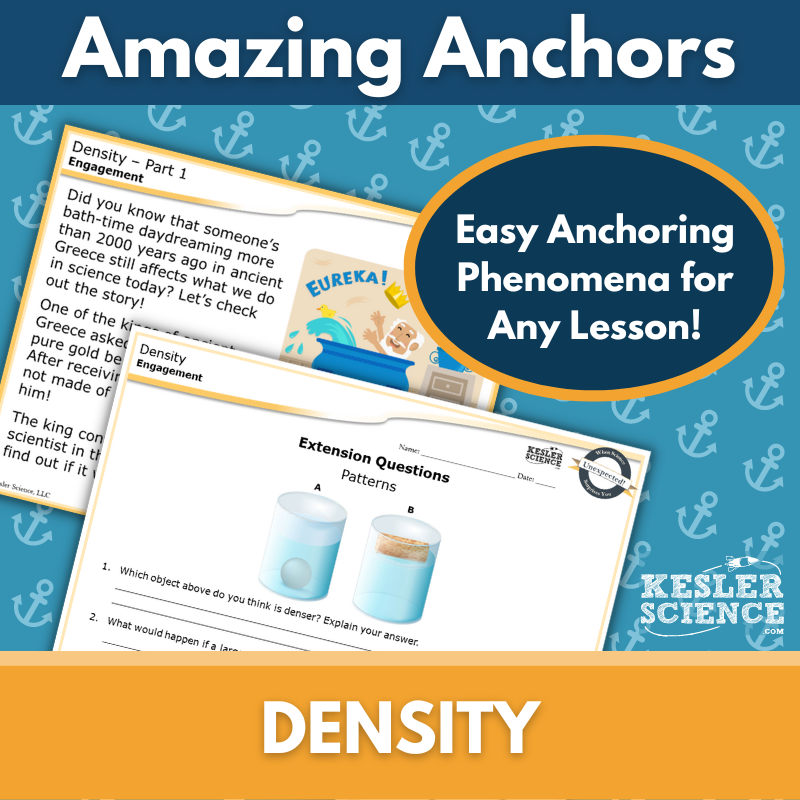Density of Regular-Shaped Objects Activities for Middle School Science
The Kesler Science Density of Regular-Shaped Objects 5E Lesson is a student-centered, low-prep unit that helps middle school students calculate and apply density to identify materials. The resources below will give students a comprehensive understanding of the density of regular-shaped objects. All of the following materials are also included in the Kesler Science Membership.
The Kesler Science Density of Regular-Shaped Objects 5E Lesson is a comprehensive, low-prep unit designed to help middle school students learn how to calculate and use density to identify materials. The lesson includes editable presentations, worksheets, interactive notebook pages, student-choice projects, and assessments. Materials are available in both English and Spanish, with flexible digital and printable formats that support both classroom and virtual instruction.
During the Exploration phase, students rotate through a nine-station, student-led lab that includes hands-on experiments, readings, videos, digital research, and creative output activities like writing prompts, card sorts, and illustrations. Each station supports differentiated learning, and a challenge station offers extension activities for early finishers. The Explanation phase provides editable PowerPoints and notebook templates to guide instruction, while the Elaboration phase features student-choice projects that extend learning beyond the lab.
To assess understanding, the Evaluation phase includes STAAR 2.0-aligned questions in both standard and modified formats, along with worksheets for class discussion or homework. With built-in support for multimodal learning, scaffolding, and customization, this lesson equips teachers to engage students in mastering the concept of density in a meaningful, student-centered way.
The Kesler Science Density of Regular-Shaped Objects 5E Lesson is a comprehensive, low-prep unit designed to help middle school students learn how to calculate and use density to identify materials. The lesson includes editable presentations, worksheets, interactive notebook pages, student-choice projects, and assessments. Materials are available in both English and Spanish, with flexible digital and printable formats that support both classroom and virtual instruction.
During the Exploration phase, students rotate through a nine-station, student-led lab that includes hands-on experiments, readings, videos, digital research, and creative output activities like writing prompts, card sorts, and illustrations. Each station supports differentiated learning, and a challenge station offers extension activities for early finishers. The Explanation phase provides editable PowerPoints and notebook templates to guide instruction, while the Elaboration phase features student-choice projects that extend learning beyond the lab.
To assess understanding, the Evaluation phase includes STAAR 2.0-aligned questions in both standard and modified formats, along with worksheets for class discussion or homework. With built-in support for multimodal learning, scaffolding, and customization, this lesson equips teachers to engage students in mastering the concept of density in a meaningful, student-centered way.
The Kesler Science Density of Regular Objects Station Lab is designed to keep middle schoolers engaged while encouraging them to take ownership of their learning. The comprehensive materials save time and allow students to explore the concept of density and apply it to identify unknown substances.
This station lab includes nine stations, each offering differentiated activities to personalize the learning experience. Students work independently or in small groups, engaging in hands-on tasks, reading, watching videos, and conducting research. Stations like "Explore It!" and "Research It!" introduce key concepts, while "Organize It!" and "Write It!" provide opportunities for students to demonstrate their understanding. A bonus challenge station is available for early finishers to expand their learning.
The stations use both physical and digital materials, making them adaptable to any classroom. Resources include signage, task cards, manipulatives, and digital tools, enabling teachers to guide rather than direct the learning process.
The Kesler Science Density of Regular Objects Station Lab is designed to keep middle schoolers engaged while encouraging them to take ownership of their learning. The comprehensive materials save time and allow students to explore the concept of density and apply it to identify unknown substances.
This station lab includes nine stations, each offering differentiated activities to personalize the learning experience. Students work independently or in small groups, engaging in hands-on tasks, reading, watching videos, and conducting research. Stations like "Explore It!" and "Research It!" introduce key concepts, while "Organize It!" and "Write It!" provide opportunities for students to demonstrate their understanding. A bonus challenge station is available for early finishers to expand their learning.
The stations use both physical and digital materials, making them adaptable to any classroom. Resources include signage, task cards, manipulatives, and digital tools, enabling teachers to guide rather than direct the learning process.
The Kesler Science Density of a Regular-Shaped Object Student Choice Projects allow middle school students to select a project that fits their preferred output style. With six different project options and the possibility to design their own, students can explore creative ways to demonstrate their understanding. A grading rubric enables assessment by teachers, peers, or students themselves.
These projects are flexible and dynamic, allowing teachers to modify the rubric as needed. The multimodal project choices offer students personalized methods to show their knowledge, catering to a variety of learning styles and abilities.
The lesson includes a choice board with nine project options plus a custom project, a teacher directions page, and editable rubrics. Two versions of the project page are available—one modified for students needing remediation and another for those who require a challenge. The projects primarily use standard classroom supplies, with some options for crafting models or digital completion.
The Kesler Science Density of a Regular-Shaped Object Student Choice Projects allow middle school students to select a project that fits their preferred output style. With six different project options and the possibility to design their own, students can explore creative ways to demonstrate their understanding. A grading rubric enables assessment by teachers, peers, or students themselves.
These projects are flexible and dynamic, allowing teachers to modify the rubric as needed. The multimodal project choices offer students personalized methods to show their knowledge, catering to a variety of learning styles and abilities.
The lesson includes a choice board with nine project options plus a custom project, a teacher directions page, and editable rubrics. Two versions of the project page are available—one modified for students needing remediation and another for those who require a challenge. The projects primarily use standard classroom supplies, with some options for crafting models or digital completion.
The Kesler Science Earth Science Interactive Notebook Bundle is a must-have for teachers who want to provide an interactive learning experience in earth science. It includes both print and digital versions, making it a versatile resource for traditional classrooms, 1:1 environments, and distance learning.
The bundle covers a wide range of earth science topics, including Continental Drift Theory, plate boundaries, rocks and minerals, the rock cycle, Earth’s layers, volcanoes, earthquakes, and more. It also features activities like Venn diagrams, topographic maps, and reflection pages to help students demonstrate understanding and make connections between concepts.
The digital version includes a unique interactive notebook PowerPoint, which can be uploaded to Google Slides or learning management systems like MS Teams and Canvas. The paper version provides blank and pre-filled templates, along with color photos to guide students in completing each activity. Both versions come with a teacher answer key and a modified version for students with accommodations.
The Kesler Science Earth Science Interactive Notebook Bundle is a must-have for teachers who want to provide an interactive learning experience in Earth Science. It includes both print and digital versions, making it a versatile resource for traditional classrooms, 1:1 environments, and distance learning.
The bundle covers a wide range of earth science topics, including Continental Drift Theory, plate boundaries, rocks and minerals, the rock cycle, Earth’s layers, volcanoes, earthquakes, and more. It also features activities like Venn diagrams, topographic maps, and reflection pages to help students demonstrate understanding and make connections between concepts.
The digital version includes a unique interactive notebook PowerPoint, which can be uploaded to Google Slides or learning management systems like MS Teams and Canvas. The paper version provides blank and pre-filled templates, along with color photos to guide students in completing each activity. Both versions come with a teacher answer key and a modified version for students with accommodations.
The Density Lab aligns with NGSS standards by guiding students through the process of calculating density to identify unknown liquids. Students will measure the mass and volume of different substances to determine their densities and use that data to uncover the identity of each mystery liquid. Both print and digital formats include comprehension questions, Claim-Evidence-Reasoning (C.E.R.) prompts, and a reflection section to promote deeper thinking.
This resource includes three differentiated versions—Dependent, Modified, and Independent—designed to meet the needs of all learners. The hands-on version uses everyday materials like rubbing alcohol, vegetable oil, and honey, while the virtual version is entirely interactive and requires no physical materials, making it perfect for distance learning or absent students.
Teachers benefit from editable PowerPoints, answer keys, and teacher resource pages with standards, objectives, and prep guidance. Whether used in print or digital format, this lab provides an engaging, flexible learning experience that helps students explore the relationship between mass, volume, and density.
The Density Lab aligns with NGSS standards by guiding students through the process of calculating density to identify unknown liquids. Students will measure the mass and volume of different substances to determine their densities and use that data to uncover the identity of each mystery liquid. Both print and digital formats include comprehension questions, Claim-Evidence-Reasoning (C.E.R.) prompts, and a reflection section to promote deeper thinking.
This resource includes three differentiated versions—Dependent, Modified, and Independent—designed to meet the needs of all learners. The hands-on version uses everyday materials like rubbing alcohol, vegetable oil, and honey, while the virtual version is entirely interactive and requires no physical materials, making it perfect for distance learning or absent students.
Teachers benefit from editable PowerPoints, answer keys, and teacher resource pages with standards, objectives, and prep guidance. Whether used in print or digital format, this lab provides an engaging, flexible learning experience that helps students explore the relationship between mass, volume, and density.
The Kesler Science Density Escape Room provides an engaging way for students to demonstrate their understanding of mass, volume, and density. Teachers have full control over the activity, selecting from eight independent puzzles that can be used in any order to suit different class periods. The escape room can be set up with simple materials like manila envelopes or enhanced with props such as locks and a storage box for a more authentic experience.
For digital use, a Single Student Digital Version is available via Google Slides, allowing students to solve puzzles and manipulate images online. A printable version in PPT or PDF is also provided for at-home use, ensuring flexibility for all learning environments.
The Density Escape Room includes detailed teacher directions, answer keys, editable templates, and digital tools like Google Forms for assessments. Additional resources such as a video challenge, printable props, reward templates, and photo props make the experience memorable and exciting for students.
The Kesler Science Density Escape Room provides an engaging way for students to demonstrate their understanding of mass, volume, and density. Teachers have full control over the activity, selecting from eight independent puzzles that can be used in any order to suit different class periods. The escape room can be set up with simple materials like manila envelopes or enhanced with props such as locks and a storage box for a more authentic experience.
For digital use, a Single Student Digital Version is available via Google Slides, allowing students to solve puzzles and manipulate images online. A printable version in PPT or PDF is also provided for at-home use, ensuring flexibility for all learning environments.
The Density Escape Room includes detailed teacher directions, answer keys, editable templates, and digital tools like Google Forms for assessments. Additional resources such as a video challenge, printable props, reward templates, and photo props make the experience memorable and exciting for students.
The Kesler Science Density Reading Comprehension activity, students learn to calculate density to identify an unknown substance by reading a nonfiction article on density. They complete comprehension questions and conduct a hands-on experiment to make and test predictions about density. The science reading activities are designed to engage middle school students and improve their reading comprehension and science literacy.
The lesson includes a leveled science reading passage appropriate for grades 6-8 (or advanced 5th graders), with two Lexile levels (1100-1300). The article is followed by 5-7 comprehension questions and a mini-project. A Cornell notes template is also provided, along with colorful graphics that can be printed in grayscale.
The resource can be used in both traditional and virtual learning environments. The reading passages are compatible with platforms like Google Classroom, MS Teams, Schoology, and Canvas, allowing students to respond directly in the document. This resource is ideal for absent students, extra credit, science sub plans, and whole-class instruction.
The Kesler Science Density Reading Comprehension activity, students learn to calculate density to identify an unknown substance by reading a nonfiction article on density. They complete comprehension questions and conduct a hands-on experiment to make and test predictions about density. The science reading activities are designed to engage middle school students and improve their reading comprehension and science literacy.
The lesson includes a leveled science reading passage appropriate for grades 6-8 (or advanced 5th graders), with two Lexile levels (1100-1300). The article is followed by 5-7 comprehension questions and a mini-project. A Cornell notes template is also provided, along with colorful graphics that can be printed in grayscale.
The resource can be used in both traditional and virtual learning environments. The reading passages are compatible with platforms like Google Classroom, MS Teams, Schoology, and Canvas, allowing students to respond directly in the document. This resource is ideal for absent students, extra credit, science sub plans, and whole-class instruction.
The Kesler Science Density Science Writing Prompt provides middle school students with an engaging way to test their knowledge of density through a skit or drama. This creative exercise enhances science reasoning while allowing students to enrich their writing skills. It is designed for both in-class and virtual learning, ensuring students remain engaged even outside the classroom.
These low-prep, high-quality writing prompts are perfect for elaboration or review, and they can easily integrate with other Kesler Science products.
Included in the purchase are teacher directions, answer guides, rubrics, projection versions, full-sized and half-sheet handouts, and a digital interactive version that works in Google Slides. This versatile activity can be used for formative assessments, student choice projects, extra credit, differentiation exercises, or as make-up work.
The Kesler Science Density Science Writing Prompt provides middle school students with an engaging way to test their knowledge of density through a skit or drama. This creative exercise enhances science reasoning while allowing students to enrich their writing skills. It is designed for both in-class and virtual learning, ensuring students remain engaged even outside the classroom.
These low-prep, high-quality writing prompts are perfect for elaboration or review, and they can easily integrate with other Kesler Science products.
Included in the purchase are teacher directions, answer guides, rubrics, projection versions, full-sized and half-sheet handouts, and a digital interactive version that works in Google Slides. This versatile activity can be used for formative assessments, student choice projects, extra credit, differentiation exercises, or as make-up work.
The WIKI Tickets© formative assessments offer flexible and engaging ways to check student understanding in middle school chemistry. This Chemistry Set includes 14 topics, each available in five formats: a full-screen version for projection, three print handouts (full-page, half-page, and quarter-page), and a digital version compatible with PowerPoint and Google Slides.
Aligned with NGSS and TEKS standards for grades 6–8, these assessments cover essential topics such as density, chemical and physical changes, conservation of mass, energy transfer, periodic table arrangement, and more. A table of contents is included to show how each WIKI Ticket aligns with specific standards, with all standards represented by at least one assessment.
WIKI Tickets© can be used in both in-person and virtual settings. Teachers can choose to display tickets on a screen, print them for student work, or assign them digitally. These versatile tools can function as exit tickets, bellringers, or quick checks to gauge learning progress throughout the unit.
The WIKI Tickets© formative assessments offer flexible and engaging ways to check student understanding in middle school chemistry. This Chemistry Set includes 14 topics, each available in five formats: a full-screen version for projection, three print handouts (full-page, half-page, and quarter-page), and a digital version compatible with PowerPoint and Google Slides.
Aligned with NGSS and TEKS standards for grades 6–8, these assessments cover essential topics such as density, chemical and physical changes, conservation of mass, energy transfer, periodic table arrangement, and more. A table of contents is included to show how each WIKI Ticket aligns with specific standards, with all standards represented by at least one assessment.
WIKI Tickets© can be used in both in-person and virtual settings. Teachers can choose to display tickets on a screen, print them for student work, or assign them digitally. These versatile tools can function as exit tickets, bellringers, or quick checks to gauge learning progress throughout the unit.
The Kesler Science Earth Science Lesson Extensions offer engaging activities for fast finishers, fostering critical thinking and creativity. These extensions are designed to scaffold learning for students ready to dive deeper into earth science topics while aligning with NGSS and TEKS standards. They provide a fun yet rigorous way to enhance lessons and keep students focused during independent work or testing.
Each Lesson Extension includes four core activities: a Puzzler to improve problem-solving, a Maker Space to promote STEAM connections, a Tech Connection to demonstrate learning through digital media, and a Word Master activity to integrate creative writing. These activities ensure students engage with the content in a variety of ways, helping reinforce their understanding.
The Lesson Extensions come with teacher directions, answer keys, and both paper and digital versions for flexibility. Perfect for wrapping up lessons or providing enrichment, these extensions cover a wide range of earth science topics like climate change, fossil fuels, and plate tectonics, all while meeting high-level science standards.
The Kesler Science Earth Science Lesson Extensions offer engaging activities for fast finishers, fostering critical thinking and creativity. These extensions are designed to scaffold learning for students ready to dive deeper into earth science topics while aligning with NGSS and TEKS standards. They provide a fun yet rigorous way to enhance lessons and keep students focused during independent work or testing.
Each Lesson Extension includes four core activities: a Puzzler to improve problem-solving, a Maker Space to promote STEAM connections, a Tech Connection to demonstrate learning through digital media, and a Word Master activity to integrate creative writing. These activities ensure students engage with the content in a variety of ways, helping reinforce their understanding.
The Lesson Extensions come with teacher directions, answer keys, and both paper and digital versions for flexibility. Perfect for wrapping up lessons or providing enrichment, these extensions cover a wide range of earth science topics like climate change, fossil fuels, and plate tectonics, all while meeting high-level science standards.
This Amazing Anchors Phenomenon Lesson introduces and reinforces the concept of density through real-world connections, focusing on the story of Archimedes. The introductory reading uses this historical context to engage students, while comprehension and extension questions help activate prior knowledge. A second, explanatory reading clearly breaks down the science behind density and includes additional questions to deepen student understanding.
This no-prep, TEKS-aligned resource includes teacher directions with answer keys, editable materials, and multiple formats to fit your classroom needs. Full-page projection slides, digital files for LMS platforms, and printable handouts in both full- and half-sheet versions are all included to support flexible instruction.
Designed to bookend a main lesson, these readings are ideal for the Engagement and Elaborate phases of the 5E model. A differentiated version with sentence starters supports diverse learners, and the print or digital format makes it easy to integrate into both in-person and virtual classrooms.
This Amazing Anchors Phenomenon Lesson introduces and reinforces the concept of density through real-world connections, focusing on the story of Archimedes. The introductory reading uses this historical context to engage students, while comprehension and extension questions help activate prior knowledge. A second, explanatory reading clearly breaks down the science behind density and includes additional questions to deepen student understanding.
This no-prep, TEKS-aligned resource includes teacher directions with answer keys, editable materials, and multiple formats to fit your classroom needs. Full-page projection slides, digital files for LMS platforms, and printable handouts in both full- and half-sheet versions are all included to support flexible instruction.
Designed to bookend a main lesson, these readings are ideal for the Engagement and Elaborate phases of the 5E model. A differentiated version with sentence starters supports diverse learners, and the print or digital format makes it easy to integrate into both in-person and virtual classrooms.
Year-Round Resources
These year-round activities will increase your students' understanding of many middle school science topics. All of these activities are also included in the Kesler Science Membership.
Visual Data & Graphing
You're not alone if your students struggle with understanding graphs, charts, and tables. It's a skill that takes an enormous amount of practice. This resource will help students build a strong foundation in analyzing data and creating their own data visualizations.
Bell Ringers and Warm-Ups
These middle school science bell ringers are an excellent way to engage your students as soon as they walk into your classroom. This comprehensive FULL YEAR resource includes everything you need to start off each science class with an interesting warm-up activity.
Review Board Games
Each game board has been carefully designed to keep students engaged. There are 10 different action spaces on each board and dozens of question cards. All of the actions are related to science concepts and keep the students motivated throughout the game.
Each game is ready to play. Simply print out the board and the cards and let the students enjoy reviewing nine different units.
Essential Questions
Below are the essential questions associated with the lessons and activities included in this unit. This topic is only one of more than 100 middle school science topics included in the Kesler Science Membership.
-
How do you calculate the density of regularly shaped objects?
-
How can calculating density determine the identity of an unknown?
Kesler Science Membership
Imagine never having to search for another middle school science lesson again. The membership gives you access to ALL of the Kesler Science products in one place (Yes, including everything above).
Say goodbye to long hours of lesson prep.

